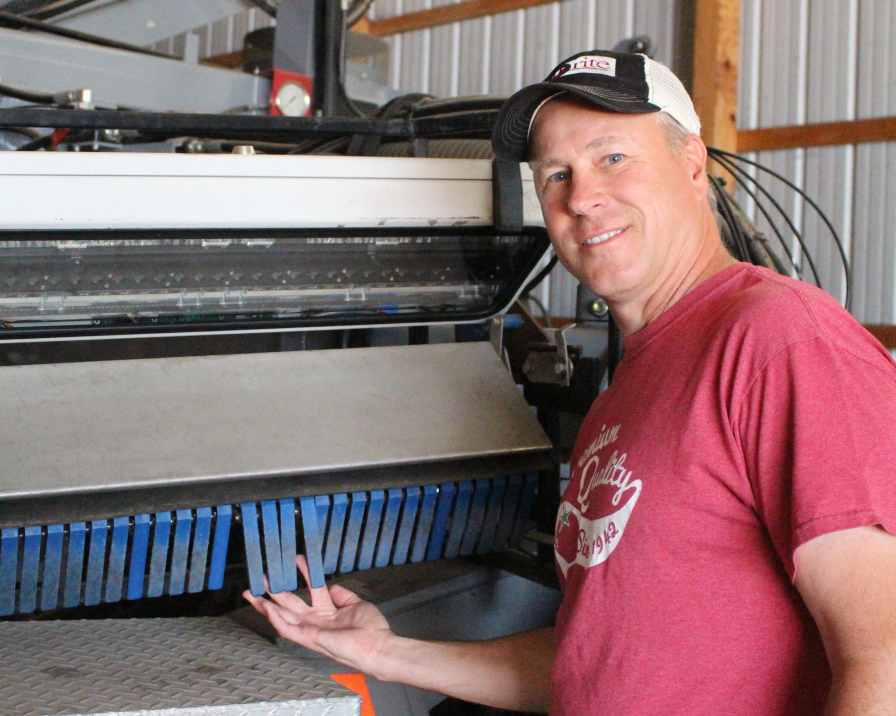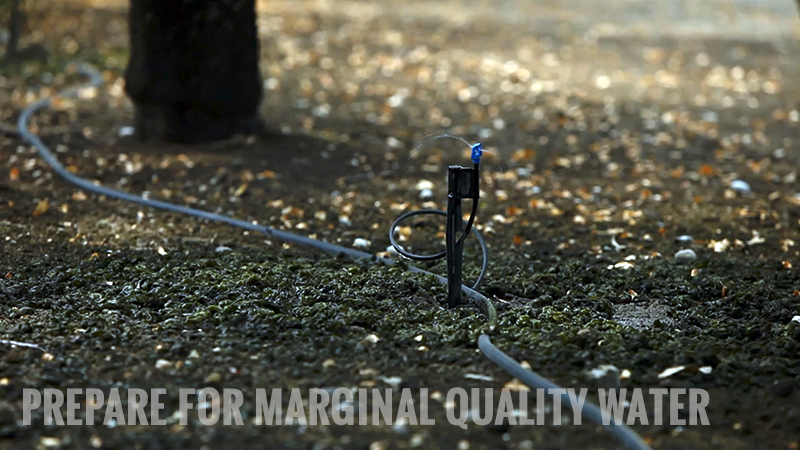Options In Harvest Mechanization For Vegetable Growers
For years, the mantra has been that we need to mechanize as much of the production process as possible, and particularly at harvest, because the labor situation is precarious at best.
A recent example is Grimmway Farms in California, which is conducting trials with robots from Harvest Automation, moving potted plants into the field to grow and then retrieving them at the end of the season for harvesting. American Vegetable Grower® magazine (AVG) reported on the work Grimmway was doing in October 2015.
Among many things, one goal of the farm was to reduce its reliance on labor.
So what are your mechanization options? In addition to the work being done by farms such as Grimmway, AVG got some insight into how a couple of others are striving to save labor and streamline the harvesting process and what an equipment manufacturer says may be on the horizon.
Paarlberg Farms:
Increase Quality, Speed, And Reduce Labor

Jim Paarlberg of Paarlberg Farms points out how the Odenberg double sorters on his Pik Rite tomato harvester feature electronic fingers that can accept or reject tomatoes. Photo credit: Gabrielle Paarlberg
For Jim Paarlberg of Paarlberg Farms in Indiana, the overall goal has been to turn in quality loads to the tomato processor.
Paarlberg, who has been growing 400 acres of tomatoes for Elwood, IN-based Red Gold Premium Tomatoes for more than 30 years, says a couple of years ago he opted to have electronic double sorters added to his Pik Rite tomato harvesters.
“The double sorters have been a game-changer for us,” he says. “The laborsavings is huge and you are delivering the product that your cannery needs you to deliver.”
How Sorters Work
In Paarlsberg’s new setup, the entire tomato plant is brought into the harvester, which is retrofitted with a double sorter from Odenberg, and two rotating brushes help to gently shake the plant to remove the tomatoes. The vines continue onto the ground and get chopped up, and the tomatoes are conveyed over a blower to remove leaves, and dropped in front of the sorter’s electronic eye.
The job of the eye is to recognize size (so it can reject objects larger than what is specified) as well as color.
“You can set it to only accept red, so green, yellow, and even dirt clods get rejected,” Paarlberg explains.
As the sorting process continues, the tomato free falls from a conveyor about an inch away from an electronic “finger” that is about 3/4 of an inch wide. The finger will push the tomato out of the flow and drop it onto the ground if it is rejected. If it is accepted, the fruit falls back onto the conveyor.
“We can have a third off-color and green [tomatoes] coming into the harvester, and the sorters will keep that number to under 5%,” Paarlberg says. A second sorter helps to ensure a clean crop, he adds.
Quality isn’t the only thing Paarlberg is able to increase in the harvesting process. Now, he can load a 22.5-ton semitrailer in 30 to 40 minutes, depending on conditions, quality, and yield. Before using the double sorters, it could take an hour or more to load a semitrailer.
“In certain conditions, if we had a lot of green and off-color tomatoes, we tried to try to clean that up by hand,” Paarlberg recalls. “If we had additional adverse conditions to deal with, it took even longer to finish the load.”
Labor Reduction
In addition to providing the tomato cannery with a quality product, Paarlberg says he has reduced the number of workers on the crew by five. Other growers have reduced labor crews even further, but he says his farm needs additional people because the sorter’s electronic fingers are moving the tomatoes faster than just a couple of people can grab.
At the end of the day, in addition to saving on labor, he says the farm will be rewarded on price for delivering a high-quality product.

Designed for labor savings, this bean harvester can handle a 100-foot row in a few minutes. Photo credit: Kerry Clark
Weidner Farm:
Time Is Money For A Niche Market Grower
Saving labor and delivering a quality product also are what Mary Ellen Raymond is trying to achieve. Raymond, who produces edamame and other vegetables on her small family operation, Weidner Farm in Bunker Hill, IL, was looking to get some type of mechanical help to get her product to farmers’ markets.
“People at the market will pay $8 per pound for green beans or edamame,” she says. “Farmers don’t want to grow them, though, because of the labor-intensive harvest.”
With her 89-year-old mother as her main source of harvest help, Raymond was a prime candidate for a SARE (Sustainable Agriculture Research and Education) grant to develop a unit that can harvest both green beans and edamame.
A Harvester For 5 Acres
It was when Raymond met Kerry Clark, a soybean breeder at the University of Missouri, that the project got off the ground. The result is a mechanical harvester that can handle 5 acres or less. The unit is designed to harvest any free-standing bush-type plant for fresh market sales.
It also is designed for major labor savings. What would have taken eight hours can be done in 20 minutes with the machine. Clark says a 100-foot row can be harvested in just a few minutes.
The mechanics of the harvester are relatively simple. A reel located between the plant and conveyor belt turns as the machine goes alongside the row, sliding up the plant, removing the pods, and then placing them on the conveyor. From the conveyor, the beans are deposited in a wagon behind the machine.
Working Out The Kinks
The plan was to have a functional machine for last year’s harvest, but a glitch in the system and extremely wet conditions in late summer halted the process. The harvesting mechanism was dropping the beans on the ground instead of placing them on the conveyor belt, but Clark says she is confident the unit will be fixed and up and running for harvest in August.
Clark and Raymond also faced headwinds with the cost of production. Virtually all parts of the prototype were milled, which was an expense that caused the price to hit $9,000.
The good news, Clark says, is if someone wants to build the machine using the plans, the cost should be about $5,000. [Editor’s note: For the harvester plans, contact Clark: [email protected].]
To date, Clark has received several inquiries about the machine. She responds to these inquiries by telling interested parties the machine needs some tweaking to keep the cost down.
“Specifically, they need to find some of the parts that are manufactured on a mass scale to use,” she says.
She also says there is an equipment manufacturer in Arlington, TX, Gnismer Farm Equipment, that specializes in small machinery and has expressed interest in the harvester if there is a market for it.
Mechanized Harvest For Fresh Market? Be Ready To Adapt Growing Practices
FOR fresh market producers who want to become more mechanized, it can be done, but you will have to change your growing practices, says Frank Maconachy, President and CEO of Ramsay Highlander, a manufacturer of specialized harvesting aids for the vegetable industry headquartered in California’s Salinas Valley.
For example, if you want to mechanically harvest fresh market celery, you will have to change the row spacing and the seed spacing for the crop.
Why? Maconachy says mechanically, he can’t get an apparatus to fit between seed lines. “It’s just too narrow of space to effectively do it without damaging the crop,” he explains.
It is a similar situation for a cabbage grower in Ohio who is interested in a harvester for a fresh market crop. To accommodate a harvesting apparatus, Maconachy says the grower will need to change from two seed lines on a bed to a single seed line.
“To a grower, that is a lot of volume loss from a field,” he says. “So these things have to be part of the discussions when you are talking about the concept of the machine you want to build and how you can do it. As an engineer and machine designer, you put yourself in these corners where you have the restraints of having the ability to put an apparatus or mechanism [where it needs to go] to do the work.”
Involving Breeders
Maconachy says he also hears from growers in the melon industry. He is currently working with a group who is talking to seed breeders about developing varieties that have the potential to produce fruit that will ripen in the field at the same time. The goal, he says, is for the grower to come through the field with a harvester once — known as a single-cut or a destruct harvest.
“If we approach it with a select-pick type system, it will be complicated and very expensive,” he adds.
A fresh market tomato grower in Florida is trying something similar, Maconachy says. Also working with a breeder, the grower’s goal is to produce tomato varieties that form a very tight cluster on the vine, making them easier for mechanical harvest.
At the end of the day, he says, growers need to be more precise on the front end of farming practices to help automation work better, and in return it will help them with better results.
“Growers need to understand that automation takes time to figure out and will require certain steps, design, build, tests, possible redesign, [modifications], and retests to get to a prototype machine to work. It is going to be costly but worth it in the end.”










